
Weapon (Blade) Designer || Self-taught Digital Artist || Filipino Martial Artist || Writes games sometimes || Mechanical Engineer || Law Student || 25 🇵🇭 twitter.com/KathangLangit || instagram.com/kathang.langit || kathanglangit.itch.io || kathanglangit.carrd.co || kathang.tawen@gmail.com
86 posts
The Sixth Blade - ... - Fear Itself
The Sixth Blade - ... - Fear Itself
Last two days! Gubat Banwa launches on Kickstarter on October 10, and we need your help to get the word out! Silence your fear- stifle it if you must. Harness it if you can. Fear begets hesitation, Kadungganan, and when rivers bleed, and skies burn, and blades dance to the rhythm of cannonfire- Hesitation is death. Let the Sword Isles of Gubat Banwa paint your stories in its thousand colors, inspired by the intricate cultures of Southeast Asia. Carve your legacy into the world by blade and smoke as warrior Kadungganan in this tactical martial arts TTRPG.
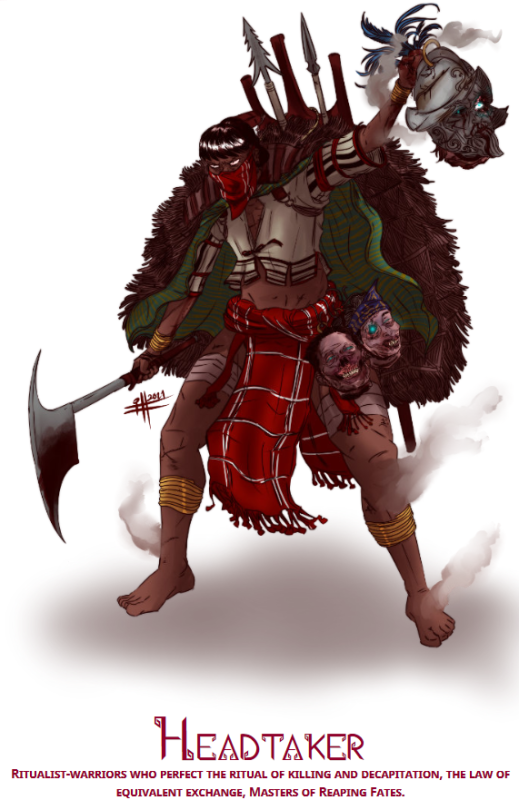
Not long now until the long-anticipated KS launch, and I've been posting the weapons I've drawn for the game as a sort of countdown. These were supposed to be Swordtember drawings, but the launch got bumped back a little bit. 6/7 blades! The penultimate entry goes to the CORDILLERAN AXE

Some time in June 2020, a certain weapon was intercepted in Australia entering the country from the United States. An ancient terror-weapon, which brought low the conquistadors of old, and drenched the soil of the pine mountains such that the ground remains the color of rust. In November the following year, the ax was returned to the Philippines. Strap in- it's about to get really convoluted.

(Photo from the Philippine Embassy in Australia) You may be wondering why I referred to this blade as a "Cordilleran Ax" rather than using a native term like in the rest of this series. That is mostly because the ax comes in many forms, and bears many, many names. Seriously, you wouldn't believe how many names there are for these things.

(Photo from the collection of Nonoy Tan) They are commonly called "head axes" (we'll get to why in a minute- but you can probably guess), referring to a collective of different blades of a more-or-less similar shape, used by the peoples of the Cordilleras. "Igorot" is a general term used to refer to these peoples of the mountains of north Luzon.

(Diagram by Lorenz Lasco)
You will recall from the thread on the hinalung that Spain never took the Cordilleras, allowing the peoples there to more easily preserve their traditions and cultures. These axes belong to some of those same cultures. These- too- were preserved from way back.

(Figure from The Tingguian: Social, Religious, and Economic Life of a Philippine Tribe by Fay-Cooper Cole) It's easy to forget that these objects- all of the blades I've been posting about- are very deeply embedded in cultures that still exist today. These peoples have their own names and stories and knowledge of these blades that I simply do not have access to the way they do. It's all I can do to try and deliver accurate info without misrepresenting anything.

(Photo from the National Museum) And try I have. This is a diagram I tried to make as a reference, way, way back.

I know a bit more now, I'm not sure if I still stand by this, I am sure that it will need some updating. Due diligence is the bare minimum we can do, to respect the knowledge of people who are still around. Allow me to try again! The one I drew in the image at the start of this thread is called the SINAWIT. This is the Kalinga variant of the axe. From what I can tell, those with the curved/concave cutting edges tend to belong in this category.

(Photo from Pinoy Blade Hunter) Supposedly, the protrusion on the handle is also indicative of a Kalinga origin.
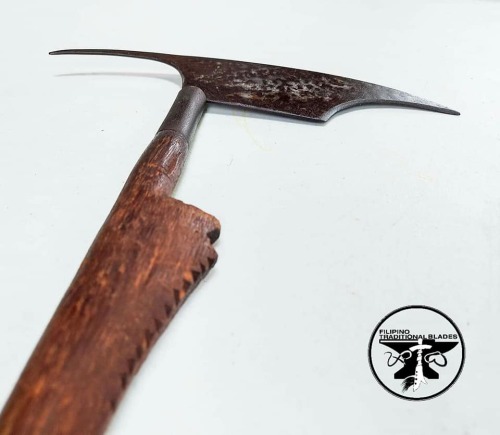
(Photo from Ursulo of Filipino Traditional Blades)
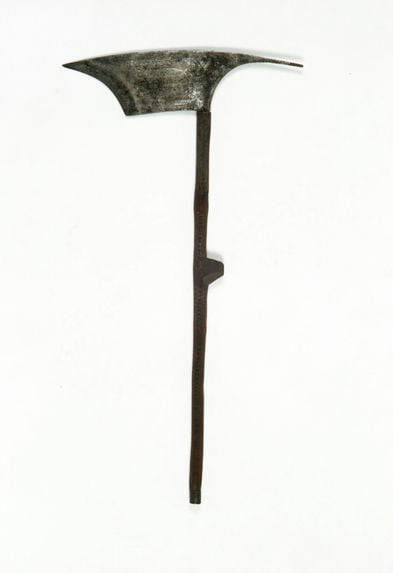

(Photos from Global Inventory of Filipiniana Artifacts) Here's some close-ups of another example, featuring ornamentation in the form of copper/copper-alloy "staples" along the handle, which may have also aided in providing grip.
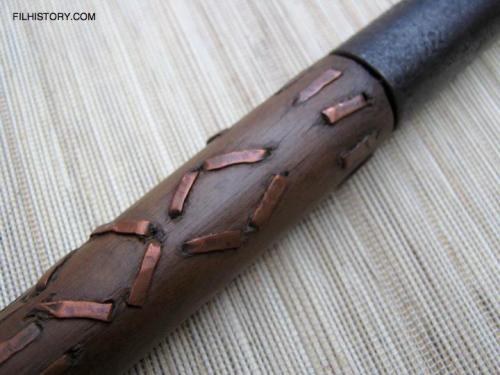

(Photos from Lorenz Lasco) Variations in size are common across all the axes we'll be looking at, some are short and fit well in one-hand, others are large enough to accommodate two. The biggest ones I've seen are sinawit.

(Photo from Christian Vasquez of Filipino Traditional Blades)

(Photo from Ron Zambarrano) Next up is the GAMEN or GAMAN. This is the Bontoc variant of the axe. Here's a gamen (top) compared to a sinawit (bottom) of similar size. Notice the difference in the shapes of the blades.

(Photo from the collection of Zel Umali as shared by Filipino Traditional Blades) Another term that gets thrown around is "pinagas", though I believe this is a general term referring to all "head axes" rather than one specific variant. I could very well be wrong on this, as the word pinagas has to come from one of the many languages in the Cordlieeras- I'm just not certain which. This one was labelled "Bontoc pinagas".

(Photo from Zel Umali) The thickness of the blade tends to vary as durability requires. In particular, the spike on the back tends to be thicker overall. Portions of the blade closer to the handle appear to be thicker as well.


(Photos from Lorenz Lasco) Examples of the gaman as I have seen them tend to have more straight or sometimes convex blades. I am uncertain if the convex shape is a unique feature, or a product of happenstance, or just how whoever used this blade liked to sharpen it.

(Photo from Pinoy Blade Hunter) They also tend to be "taller" than sinawit I've seen, with blades that are almost like squares with spikes on the back, as opposed to sinawit that are more rectangular. Still following so far? Good- it's going to get more complicated soon.


I am not- by any means- formally educated on Philippine blades, so always take my words with a grain of salt. This ax inherited by a blacksmith in Baguio is something that might be gaman, but I can't categorize it with certainty without knowing more. The profile is not exactly the same, the spike is considerably longer and more curved.

(Photo from HanYan Blades) But that's the least of our worries! The ALIWA, BINARAWAD, BADAN, BADON, BINAROY are only some of the terms used to refer to the Isneg variants. Remember when I said it would get convoluted?
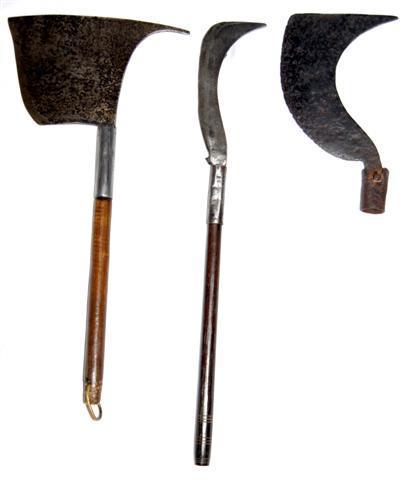
(Photo from Nonoy Tan; Identified as binarawad-badan-badon in that order) The binarawad in the previous photo looks- to my very untrained eye- to be similar to the gaman in many respects. Whenever I think I've identified a distinction, a different specimen shows up.

(??? from Rob Miller)

(Gaman(?) from Hearst Museum) Remember when I said the protrusion on the handle was uniquely Kalinga? But I also said taller/squarer blades were common in gaman? But the swept shape on the back looks emblematic of the Isneg variants we just saw? Identify that topmost blade for me, real quick.

(Photo from Pinoy Blade Hunter) Material exchange of culture makes a mess of categorization. The peoples of the Cordilleras regularly interacted- by trade, union, or warfare- and the influences clearly went all ways. Perhaps that blade above was made by a smith who took influences from a variety of sources. Perhaps the blade itself has worn out its old handle, and the new owner replaced it with this one There are a lot of ways this could have come about, it's difficult to say. Blades tend to make their way around. This sinawit- a Kalinga blade- has been passed down through generations, and was found in Sagada.

(Photo from Pinoy Blade Hunter) It certainly doesn't help when blades are found far from home and are labelled with confusing specific terms or useless general terms or just different terms entirely.
[Author's Note: Apparently there's a 30 image limit per post? I'll continue this in a reblog, I think.]
-
 right-jack-at-ya liked this · 1 year ago
right-jack-at-ya liked this · 1 year ago -
 lordmonbodo reblogged this · 1 year ago
lordmonbodo reblogged this · 1 year ago -
 talps90 liked this · 1 year ago
talps90 liked this · 1 year ago -
 spatialapprentice liked this · 2 years ago
spatialapprentice liked this · 2 years ago -
 darklordreasonable reblogged this · 2 years ago
darklordreasonable reblogged this · 2 years ago -
 not-a-farrier liked this · 2 years ago
not-a-farrier liked this · 2 years ago -
 velveteen-mango liked this · 2 years ago
velveteen-mango liked this · 2 years ago -
 knaveofaces113 reblogged this · 2 years ago
knaveofaces113 reblogged this · 2 years ago -
 knaveofaces113 liked this · 2 years ago
knaveofaces113 liked this · 2 years ago -
 red-red-spout reblogged this · 2 years ago
red-red-spout reblogged this · 2 years ago -
 bobertflaming reblogged this · 2 years ago
bobertflaming reblogged this · 2 years ago -
 y-ddraig liked this · 2 years ago
y-ddraig liked this · 2 years ago -
 thisblackwitch reblogged this · 2 years ago
thisblackwitch reblogged this · 2 years ago -
 thisblackwitch liked this · 2 years ago
thisblackwitch liked this · 2 years ago -
 antivirusadversary reblogged this · 2 years ago
antivirusadversary reblogged this · 2 years ago -
 did-you-reboot liked this · 2 years ago
did-you-reboot liked this · 2 years ago -
 cat-of-many-faces reblogged this · 2 years ago
cat-of-many-faces reblogged this · 2 years ago -
 cat-of-many-faces liked this · 2 years ago
cat-of-many-faces liked this · 2 years ago -
 worsethanmanyfairies liked this · 2 years ago
worsethanmanyfairies liked this · 2 years ago -
 averyterrible liked this · 2 years ago
averyterrible liked this · 2 years ago -
 darklordreasonable liked this · 2 years ago
darklordreasonable liked this · 2 years ago -
 burnedbridgets reblogged this · 2 years ago
burnedbridgets reblogged this · 2 years ago -
 burnedbridgets liked this · 2 years ago
burnedbridgets liked this · 2 years ago -
 selki liked this · 2 years ago
selki liked this · 2 years ago -
 xxxdragonfucker69xxx reblogged this · 2 years ago
xxxdragonfucker69xxx reblogged this · 2 years ago -
 krazybomb reblogged this · 2 years ago
krazybomb reblogged this · 2 years ago -
 sentrymon liked this · 2 years ago
sentrymon liked this · 2 years ago -
 wizard-mp4 liked this · 2 years ago
wizard-mp4 liked this · 2 years ago -
 bikerkitten reblogged this · 2 years ago
bikerkitten reblogged this · 2 years ago -
 ficklegeese liked this · 2 years ago
ficklegeese liked this · 2 years ago -
 inkblot-vigilante reblogged this · 2 years ago
inkblot-vigilante reblogged this · 2 years ago -
 rcainebuild liked this · 2 years ago
rcainebuild liked this · 2 years ago -
 nose-just-vibing liked this · 2 years ago
nose-just-vibing liked this · 2 years ago -
 ceanshaunerry liked this · 2 years ago
ceanshaunerry liked this · 2 years ago -
 yoshicolonoscopyfootageofficial reblogged this · 2 years ago
yoshicolonoscopyfootageofficial reblogged this · 2 years ago -
 carthus-flame-arc reblogged this · 2 years ago
carthus-flame-arc reblogged this · 2 years ago -
 xxxdragonfucker69xxx liked this · 2 years ago
xxxdragonfucker69xxx liked this · 2 years ago -
 tenosit reblogged this · 2 years ago
tenosit reblogged this · 2 years ago -
 tenosit liked this · 2 years ago
tenosit liked this · 2 years ago -
 oinonsana reblogged this · 2 years ago
oinonsana reblogged this · 2 years ago -
 oinonsana liked this · 2 years ago
oinonsana liked this · 2 years ago -
 poelmo reblogged this · 2 years ago
poelmo reblogged this · 2 years ago -
 fearhyren liked this · 2 years ago
fearhyren liked this · 2 years ago -
 pissplasmicpantom liked this · 2 years ago
pissplasmicpantom liked this · 2 years ago -
 spooks-mcgee liked this · 2 years ago
spooks-mcgee liked this · 2 years ago -
 thecava liked this · 2 years ago
thecava liked this · 2 years ago -
 phosphorescenc3 reblogged this · 2 years ago
phosphorescenc3 reblogged this · 2 years ago -
 togidemi reblogged this · 2 years ago
togidemi reblogged this · 2 years ago
More Posts from Kathanglangit
Seven Blades Until Glory
Gubat Banwa launches on Kickstarter TODAY! Just a few more hours before the highly-anticipated launch of this award-winning, SEA fantasy-based, tactical martial arts TTRPG. Godsfuck, that's a lotta adjectives.

I've been posting the weapons I've drawn for the game to count down the final week before the launch. These were supposed to be for Swordtember but we had to move it back a little bit.

Below are links to all the individual threads, providing details on each of these individual blades, including which cultures they belong to and how they might have been (and still are) used.







The Gubat Banwa Kickstarter launches in a few hours! Check it out here:

The Fourth Blade: Panabas - "For Chopping"
Four days to the launch of the white-hot lightning that is the Gubat Banwa Kickstarter! Gubat Banwa is a TTRPG supported by the twin pillars of tactical martial arts and contemplative war drama. Meditate upon love and violence as warriors of a burning world. Will you stem the tide of blades? Or is it rising by your will?

I'll be posting the weapons I've drawn for the game as a countdown until the launch on October 10. This was supposed to be a Swordtember series, but we needed a little more time to gain momentum. 4/7 blades, past the halfway point, let us proceed with the PANABAS
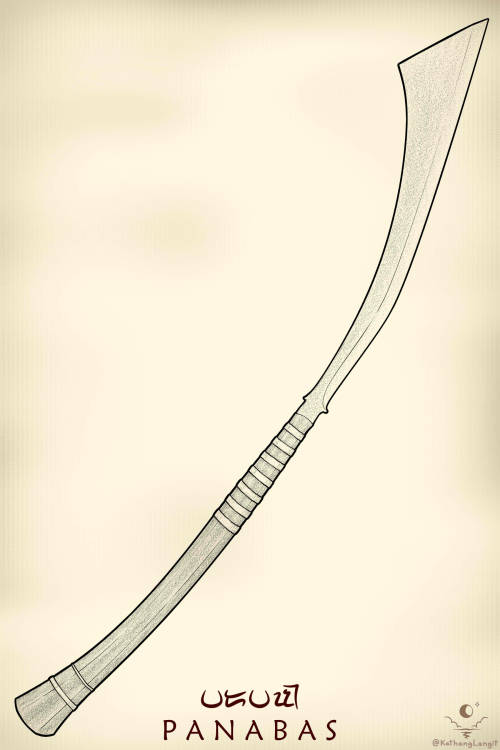
Towering amongst what blade collectors categorize as "Moro weaponry", the panabas is quite possibly the largest blade I've ever drawn. Like- I'm not lying, I drew all the blades in this series to scale relative to each other, and the panabas has by and large been the one determining how big my canvas needs to be. The edge is on the longer curve, the spine of the blade is thicker near the handle, and the handle is about as long as the blade (if not longer).

(Photo from Kristian Josef Acedo)
The form belies the function; it isn't difficult to guess how this blade is used just by looking at it. The name- if I'm not mistaken- is an even bigger giveaway. Panabas supposedly comes from "pang-tabas" which literally means "for chopping". It also goes by the name of nawi.
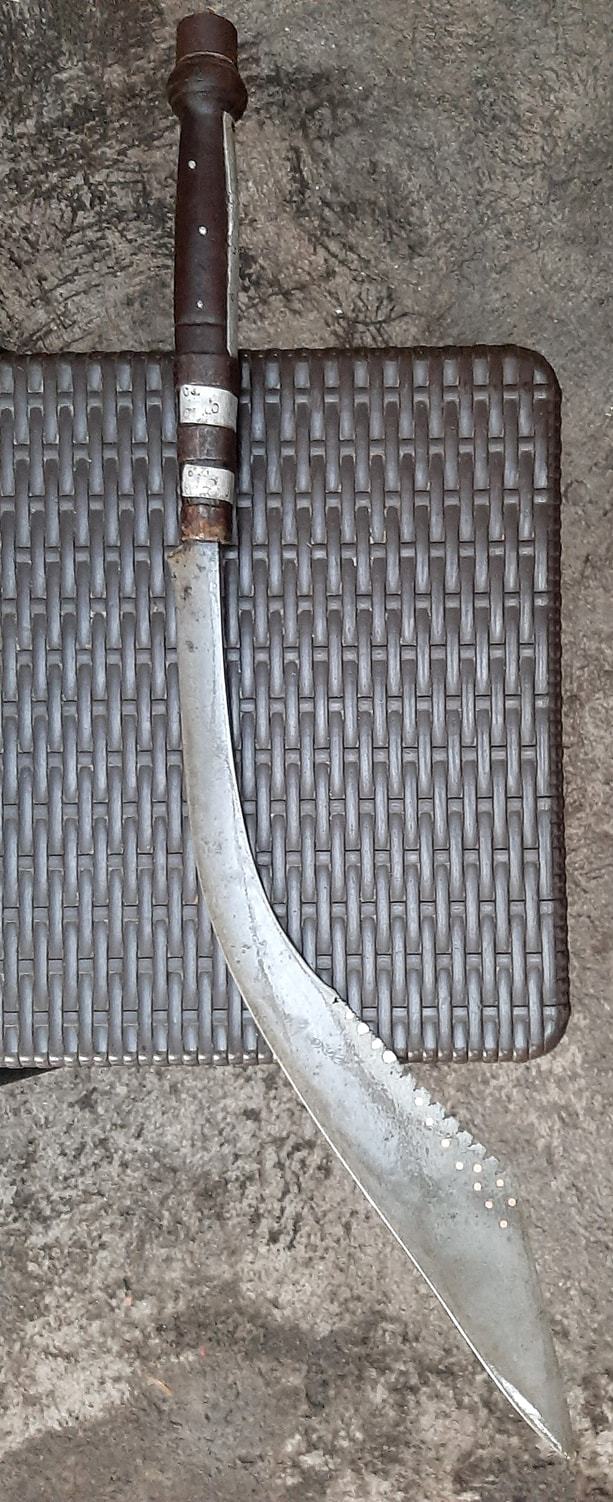

(Photos from Raymundo Lucero) As large as its reputation might be, the choppers aren't always massive. Their utility ranges from agricultural to combative to ceremonial, and the size and shape usually matched the nature of the work.

(Tools from Datu Paglas, Maguindanao)
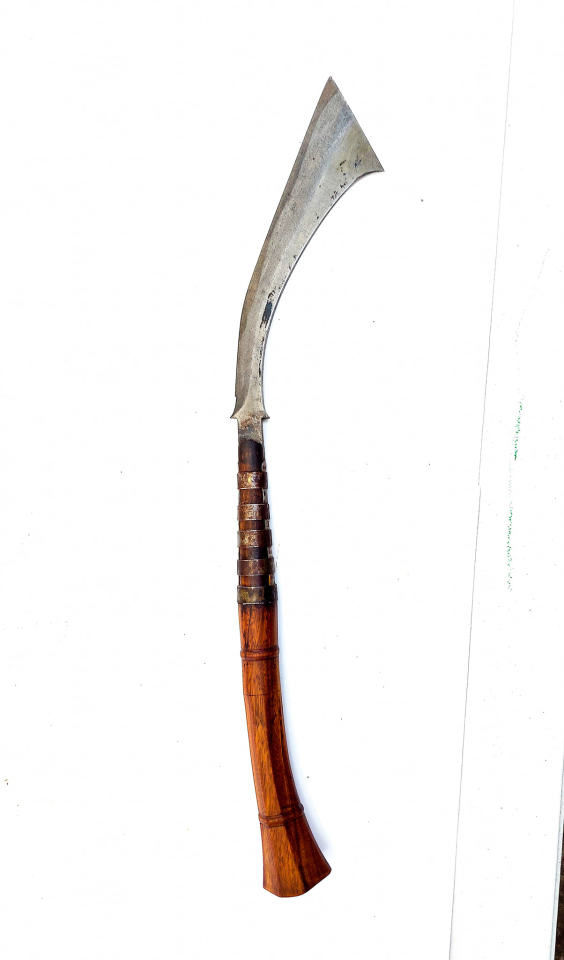
(Photo from Dondon Dimpas)

(Exhibit at Museum of the Filipino People- biggest one) The panabas is most often attributed to the peoples of Maguindanao, though the range of its use and the variants of its make span across large portions of the Mindanao area.

(Antiques from the collection of Richard Hudson, size comparison with a kalis) A popular tale (especially amongst Filipino Martial Artists) states that the US Marines wore leather collars to protect their necks during the American Occupation in Mindanao, due to blades like these that gave the troops pause, and feel that the extra protection was necessary. Supposedly, this is where the term "leatherneck" came from. Although the veracity of this latter claim is a bit on par with the claim that the Colt .45 was invented specifically to stop the same Moro warriors, the story has already stuck.

(Antique from Lake Lanao)

(Photo from The Metropolitan Museum of Art) We touched upon "Traditional" blades last time, referring to blades made by the same people to whose cultures those blades belong. This time we look at the other side of the coin. "Modern" is the term collectors here often use to refer to reinterpretations, usually by modern smiths who are separate from where a blade traditionally belongs. The point of reference I used for "Traditional" blades before is a katana forged by a traditional Japanese swordsmith. If- instead- a white blacksmith in America were to forge a katana using their own smithing methods, that would be considered as a "Modern" blade under this categorization. I'll leave it to you to spot the differences in these next few photos:

Traditional panabas with a rattan ferrule (Photo from Lorenz Lasco)

Modern blades by Jun Deuna (Espanola) and RE Pandayan (Quezon) (Photo from Dennis Andrew Golez)

Traditional blades (Marawi and Maguindanao) (Photo from Dennis Andrew Golez)

Modern full-tang build by Traditional Filipino Weapons (I know who forged this but I won't doxx their location) (Photo from the TFW website)

Modern full-tang build by Batangas Armory (Batangas) (Photo from Job Abat)

Pair of panabas and a binuaya (leftmost) by Traditional Moro Blade, Maguindanaon (Maguindanao)
Say it with me this time! Blade culture is alive and still developing. Mindanao was never conquered by Spain- the fierce resistance of the Moros made sure of that- and again it shows in the blade cultures. Though the panabas is now popular enough to have modern reinterpretations made by smiths across the Philippines, the traditional panabas and the people who make them are still around.
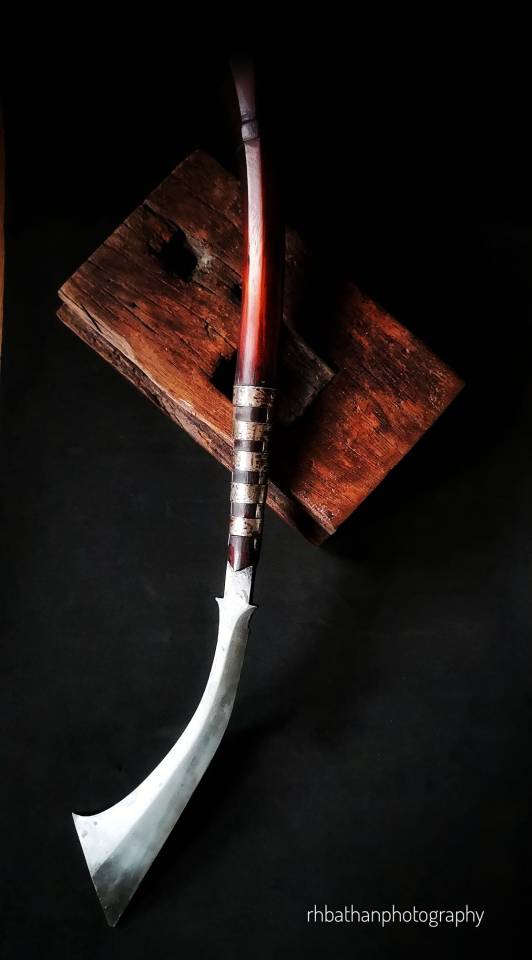
(Photo from Iniingatang Talim at Kaluban, taken by Ramon H. Bathan)
One of the Five Major Mahamandalas of Gubat Banwa pays homage to and gleans inspiration from living cultures like those I mentioned here. Yes- I repeated the text from the previous installment, because it's equally true, here. Additionally, the panabas shows up as the iconic weapon of the Martyr- one of the 25 Disciplines (read: "character classes") whose moon-bright martial techniques you could pick up in-game. Anyway, go check out the Kickstarter!
The Gubat Banwa Kickstarter launches in 4 days! Check it out here:

Not long now- this is a very small team of creators from the global south knocking on your doors asking for help to get the word out. I truly cannot understate how small this team is, and how amazing it is that they've come this far- we just need a little bit of a boost! With your help, this grand ambition can be realized. We would greatly appreciate any help rendered towards getting more eyes on this game!
The First Blade: Balaraw - Winged Dagger
I realize I haven't been explicit about it on here yet (mostly because I'm not the best at keeping all my social media profiles up to date), but I am involved in the development of a Tabletop Roleplaying Game It's called Gubat Banwa- a TTRPG based around tactical grid combat, contemplative war drama, and high-flying martial arts, all of which taking place in an unapologetically Southeast Asian-inspired fantasy setting, developed by @makapatag with art direction by @villain-returns. Initially I developed the script that is used in the gamebook and diegetically in the setting- called Kasuratan- but I'll talk about that elsewhere.

With the Kickstarter launch imminent, I thought I'd do a bunch of Twitter X threads on a bunch of weapons I've drawn for the game counting down the final week before the launch. Then I thought: "Why aren't I posting these on tumblr also, at least I wouldn't lose my mind over character counts over here"- so here we are. These were supposed to be posted as Swordtember drawings, but then the KS launch got moved to October. Most of these blades are of Philippine make, since that is where my knowledge-base is and what I'm comfortable enough to share knowledge about. I thought it'd be nice to share a bit of blade knowledge from some of the cultures that inspired the setting. Without further ado, let us begin with the BALARAW.

Also known as a "winged dagger", it is characterized by its unique shape, consisting of a short leaf-shaped blade driven with the tang out into a hilt with two distinct protrusions, creating three prongs on the back with the tang included.

(Photos from an exhibit at The Met)
They may be held at the hilt like a regular knife, or they may be held in a manner not too dissimilar from how our neighbors in Southeast Asia hold keris. One may imagine it like a "push dagger" for lack of other reference points. It might be likened to the katar as well, in some sense.


(Sketches by the Gubat Banwa Art Director himself) Nowadays, the blade is frequently attributed to the People of the Upstream- the Mandaya group of peoples- though they would have seen much wider use in their day, likely also spanning across what is now the Visayas region of the Philippines.

(Modern rendition by Panday Keiven Tolentino of Itak Mindoro, Photo by Ramon H. Bathan) Something I've noticed from looking at Philippine blades all the time is that symmetrical, double-edged blades like these are rare, here. Blades that lend themselves more to stabbing than anything else aren't very prevalent either, and blades that do not- at first glance- appear to be made with tool use/foliage clearing/farmwork in mind don't make up the majority of specimens. The balaraw is unique in several different respects, and any self-respecting warrior Kadungganan of Gubat Banwa's Sword Isles would do well to mind its bite. The weapon makes an appearance in Gubat Banwa in the hands of the Beast Hunter- one of the many Disciplines ("character classes") whose techniques your character can learn in-game.
The Gubat Banwa Kickstarter launches in 7 days! Check it out here:

We'd appreciate any and all help in getting the word out. Support an independent TTRPG made by a team from the global south, looking to make waves through a fantasy setting where the Southeast Asian inspirations takes center stage!

This is an incredibly sad thing to share but I feel like I have to. I’m not a defeatist but I don’t want to downplay the human toll, either.
I’d have to look up some words (it’s not in dialect) or have some help from someone better at this than me to do a better and more direct translation, but the gist of what Motaz is saying is that the pause has ended and it’s about survival now. He’s been transferred(? Moved around?) through all of it and he swears he’s done what he could in service of his country. He lives now in a new period of internal siege; there’s no escape from any direction. He is surrounded by Israeli tanks in central Gaza in a tragedy beyond imagination. He wants us to remember that Palestinians are not content to be consumed, they’re a people being murdered and a cause to protect from erasure…he ends with an expression of loneliness and abandonment and that’s why I can’t not share this. Those of us who are physically safe need to stay steadfast and keep pushing.

Dugong (Dugong dugon)
@ martin_the_mako_kostal